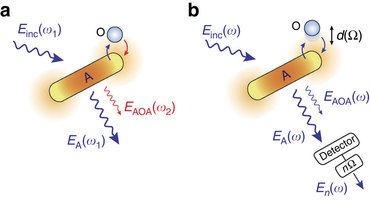Nature Communications: Resolving the electromagnetic mechanism of surface-enhanced light scattering at single hot spots
In a recent article (P. Alonso-González, et al., Nat. Commun. 3, 684) researchers from the nanooptics and the nanodevices groups at nanoGUNE provide experimental evidence that the intensity elastically scattered off the object scales with the fourth power of the local field enhancement provided by the antenna, and that the underlying electromagnetic mechanism is identical to the one commonly accepted in surface-enhanced Raman scattering.

Light scattering at nanoparticles and molecules can be dramatically enhanced in the ‘hot spots’ of optical antennas, where the incident light is highly concentrated. Although this effect is widely applied in surface-enhanced optical sensing, spectroscopy and microscopy, the underlying electromagnetic mechanism of the signal enhancement is challenging to trace experimentally. In their experimental set-up the research team has analyzed elastically scattered light from an individual object located in the well-defined hot spot of single antennas, as a new approach to resolve the role of the antenna in the scattering process. They have also measure the phase shift of the scattered light, which provides a novel and unambiguous fingerprint of surface-enhanced light scattering.
(a) Inelastic scattering process (ω1≠ω2) from an object (O) in the presence of a metal nanostructure that acts as an optical antenna (A). (b) Elastic scattering process (ω1=ω2=ω). Einc(ω) denotes the incident field, EA(ω) is the field directly radiated by the antenna, and EAOA is the field radiated by the object via the antenna. To select EAOA, the antenna–object distance d is modulated at frequency Ω, and the detector signal is demodulated at the higher harmonic frequency nΩ.
The results provide a rigorous verification of the widely accepted electromagnetic enhancement mechanism in surface- and antenna-enhanced spectroscopy, more than 30 years after it was proposed to explain the electromagnetic contribution in SERS. It is also established that the enhancement mechanism for elastic and inelastic (Raman) scattering is the same, and thus generalize the electromagnetic mechanism of SERS. Furthermore, the verification of the phase shift involved in the elastic scattering process introduces a new paradigm to characterize and manipulate surface-enhanced coherent scattering processes, which might be of fundamental and technological importance in optical information and sensing applications.
The findings might have particular implications in surface-enhanced infrared absorption (SEIRA) spectroscopy, where objects adsorbed on rough metal films or antennas exhibit an enhanced infrared fingerprint spectrum. On the one hand, the scattering from the object, which is usually neglected, might be a significant contribution to the spectrum. On the other hand, the strongly enhanced scattering cross-section might be applied for the development of surface-enhanced infrared scattering spectroscopy.
Rainer Hillenbrand
Nanooptics Group
CIC nanoGUNE Consolider
Tolosa Hiribidea 76 E-20018 Donostia – San Sebastian
r.hillenbrand@nanogune.eu
www.nanogune.eu
